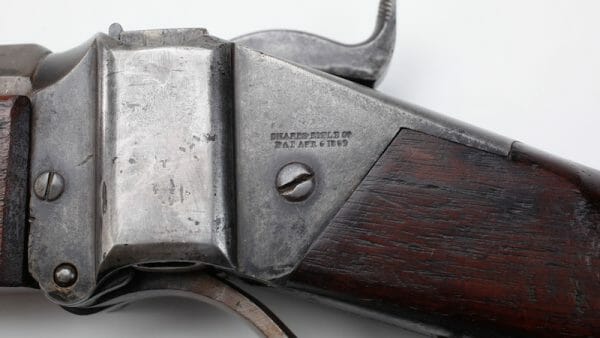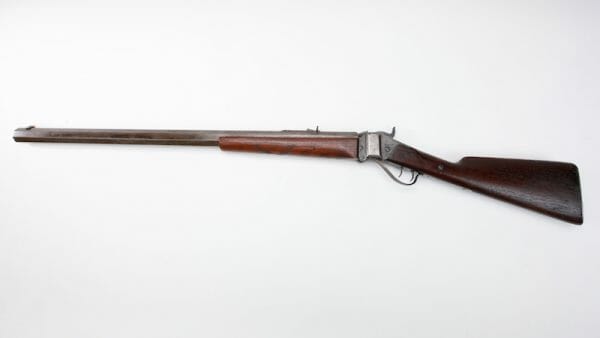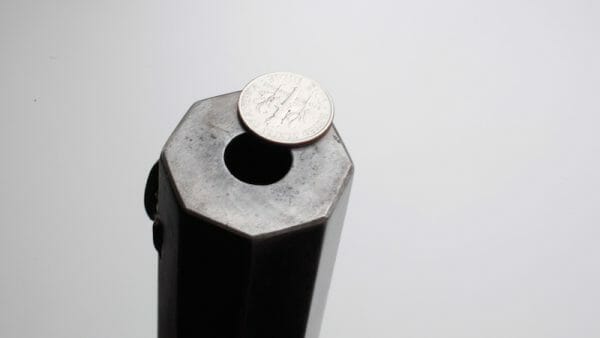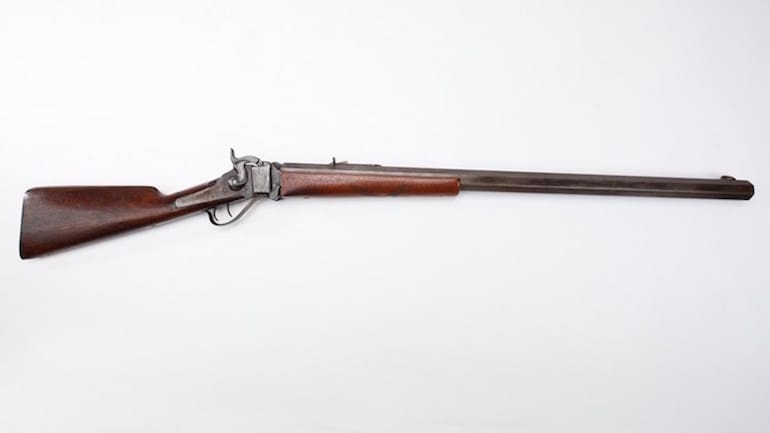One of the best examples is a Sharps rifle, originally chambered for the .45 2 7/8 cartridge or the .45-100 round. This Model 1874 Sharps arrived in the collection in 1975 and really had no history attached to it other than being an old gun from a donor in Montana. There were features on the rifle that provided some clues. The heavy barrel, the double-set triggers, and the powerful chambering, all pointed towards a big game rifle of the 1870s.

In the far West, hunters followed buffalo herds in two main regions: north and south. In the north, bison traveled through the states of Colorado, Wyoming, and Montana. This was considered the northern herd that could be hunted only during certain months of the year as bad weather limited access. In the southern states of Kansas, New Mexico, and Texas, another herd could be hunted nearly year-round. As a result of this, the southern herd was the first one decimated.
Looking over the Sharps rifle, wear patterns indicated that this gun had been shot a tremendous amount. What looked to be a replacement forestock was crudely hand-checkered. This is likely in an attempt to provide traction during firing as the recoil of a .45-100 cartridge was impressive.
The “100” in the caliber designation meant that a hundred grains of blackpowder could be packed into the long brass cartridge case behind a soft lead projectile. The double-set triggers were another indication that the rifle was a hunting arm as these triggers were not permitted in target competition at ranges like Creedmoor on Long Island.
The weight of the rifle – nearly sixteen pounds – also exceeded the limit for Creedmoor competition and this overage was easily accounted for in the size of the barrel which is a massive octagonal item.

Ft. Griffin was established in 1867 on land between the West Fork of the Trinity River and the Clear Fork of the Brazos. While initially a military fort, it soon attracted those who set up a variety of businesses – legal and otherwise. It was here that Wyatt Earp first met Doc Holliday, in Shaunissey’s saloon.
Any vice desired could be found in this “Babylon of the Brazos.” More than 186 Sharps rifles were shipped to the Ft. Griffin dealers, but the fort itself was to close in 1880 and the related civilian dealers also had shut down by then.

By 1877, the southern harvest in buffalo hides was dwindling, but hunters continued to resupply at Ft. Griffin and head outwards in wagons. With a buffalo rifle such as this one, an excellent shot could bring down a buffalo bull at distances out to 500 yards and could continue to shoot at surrounding buffalo until the herd moved off. There are records of 70, 80, and 100 buffalo being shot at one time. In the dry Texas heat, a good team of skinners would strive to keep up with the shooters.
In 1877, following the Red River Campaign of 1874 that culminated at nearby Palo Duro Canyon, most of the Native American competition for the buffalo had been eliminated. Just three years before, in 1874, another M1874 Sharps rifle in .50 caliber had been employed at long range at Adobe Walls in Texas to drive off Indian attacks.

We can’t ever know how many buffalo this one rifle might have taken in Texas, but with its later donation coming from Montana, it is very possible that the same hunter who bought it in Texas then traveled north to continue their harvesting of buffalo.
Eventually, both herds were wiped out and only scattered remnants in Canada survived. But the lesson of the buffalo was not lost on American hunters and naturalists in later years. The laws that were set up to protect and replenish game species came from the unregulated slaughter out on the plains. Brought back from the brink of extinction, the American buffalo continues to thrive in the West and other locations.
Today, this powerful single-shot Sharps is displayed in an exhibit that captures the Western frontier where it can continue to tell the story of buffalo hunters and soldiers while also drawing attention to its unique features like many historic arms of the period.
Check this exceptional out by visiting the NRA National Firearms Museum in Fairfax, Va., or click here to view the galleries online.





I’ve shot the 45-70 rifle and own a .58 cal black powder 3 band enfield , this would have been a cannon. I wonder what the ballistics would be like compared to modern rifles?
** note the type of sights on the rifle, how would you shoot that far with the very small ramp sight??
I don’t think the owner was going for long range. I think he was probably more interested in raw stopping power at fairly short ranges.
Wouldn’t a 12ga slug have done that? With that sight I don’t think you could shoot more than 100 yards?
They didn’t have the foster slug design back then, just round balls. A round ball doesn’t penetrate as well as a bullet and obviously isn’t as accurate.
The story says they were used out to 500 yards.
These rifles were used at ranges out to 500+ yards. Getting too close to a herd of bison would make the rifle report spook the bison. The professional bison hunters wanted to be much further away, so as to not spook the bison herd with their report, and still drop one bison after another as the bison calmly grazed to and fro.
Used as a sharpshooter’s rifle, these rifles could be used at ranges over 1,000 yards. There were sight sets made for them that allowed a competent man to lay bullets down on a man-sized target at ranges over 1,000 yards away. Mind you, the bullets would be coming down at a steep angle, so range estimation was of critical importance. But it was done, and it was done many times. The most famous long-range shot with a Sharps was Billy Dixon’s shot at a mounted Indian at over 1,500 yards with a “Big 50” Sharps.
Here’s a set of pictures of a target Sharps rifle. NB the aperture sights:
http://www.nramuseum.org/guns/the-galleries/innovation,-oddities-and-competition/case-24-creedmore,-sea-girt-and-exhibtion-shooters/sharps-sharps-borchardt-model-1878-mid-range.aspx
Ok, that makes sense. Very cool rifle.
** On the Round ball, I’ve found they are more accurate. Maybe it’s just me. Also you can shoot fish with the round ball 🙂
It seems like it also would not be safe to stand too close to a bison herd. Regardless of what you’re packing.
Wow. 46 dollars in 1877 was a lot of money. Somebody was flush when they saw that gun in the shop.
.45-100. Off of sticks. And the guy doing the shooting maybe weighed 140-160 pounds.
Just for comparison: my .50 cal Kentucky Rifle shoots a 177 grain round ball with 60 grains of powder.
This monster shot with 100 grains… 🤠
And probably a bullet in the 500 grain class.
Well, let’s have some honesty here.
First, the slaughter of the bison wasn’t due to “unregulated hunting.” It was a deliberate campaign to starve the Indians off the Plains and push them onto the reservation system.
Second, the American Bison isn’t “thriving” as they were. At their peak, there were probably over 30 million bison in North America – and perhaps as high as 45 million. Some photos I’ve seen in museums here in the west, taken from early explorers and travelers of the west, show large areas of Wyoming and the Dakotas that are simply black with bison, moving north or south with the snows. I’m talking of coming into large grassy areas and seeing perhaps 100K bison moving as a group. Today, there’s perhaps 250K bison total in the US, all totaled. Most of them are on private ranches.
My understanding was that the leather from the hides, especially the shoulder area, was in demand in factories. Machines were powered by drive shafts overhead and the leather belts powered the individual machines from the shaft. Bison was considered superior to cow for this purpose.
Profit motive is always a biggie.
As I understand it there’s even fewer of the 100% bison than that. In their attempts to rebuild the population without massive inbreeding many were crossed with common cattle and the majority of the bison nowadays are actually “Beefalo”.
I wonder why a single shot rifle needed two triggers?
Use the Google machine to find out more about “Set Triggers.” You will find it very interesting.
Short version, set triggers were used to get a very light trigger pull and the accuracy that comes with it.
Interesting.
I’ve never heard of a 45-100, but Sharps also made 50-95 , 50-100 and 50-110.
But then, there are muzzle loader hunters to this day who insist on using “magnum” loads of significantly greater than 100 grains of powder. Silly, if you ask me. More than 100 grains really isn’t needed to down anything in North America.
Sharps made a bunch of straight-walled cartridges, and chambered for several others.
There were many Sharps rifles chambered in .45-70 Government, then the Sharps-specific cartridges were:
.45-90 (same as the .45-70, just with a longer case – .45-70’s could be fired in a .45-90 chamber)
.45-100 (2.6″ long case)
.45-110 (2.875″ long case)
All of these were brought out in the mid-1870’s. Bullets were all cast lead, between, oh, 320 to 550 grains. The .45-90 was probably the most popular of the three.
A few years later, the .45-120 and .45-125 were brought out. There aren’t too many Sharps rifles so chambered out there.
The Sharps .50-90, .50-100, .50-110 were all the same case (2.5″ long), loaded with different charges (more powder for lighter bullets which took up less room in the case for the same OAL). The “Big Bore” or “Texas 50” was brought out by Sharps in 1872, if memory serves, and hurled a bullet up to about 600 grains. The .50-90 was preferred by more than a few professional/commercial bison hunters.
Why the 90, 100, 110, 120, 125, etc grains of powder? Because these were all black powder cartridges, and when you stoke more and more BP into a case, you don’t get a large increase in muzzle velocity. Black powder is an explosive, not a propellant, and it doesn’t behave as nitrocellulose powders do. You can load a BP firearm plum full of BP, and as long as you don’t have an air gap between the powder and the projectile, you don’t get a huge increase in pressure. You get an increase in recoil (because of the increased mass of the powder being ejected from the muzzle), but your muzzle velocities don’t go up that much – because the pressure under the projectile won’t go up that much with more and more black powder, as it would with modern smokeless powders.
If someone is buying a Sharps reproduction to shoot today, I’d recommend .45-70 as the chambering, because the brass costs so much less. Here’s a good indication of what brass costs to feed these beasts:
https://www.starlinebrass.com/order-online/long-range-black-powder.cfm
NB the difference between .45-70 and, well, everything else.
I have a catalog page from E.C. Meacham Arms co., St. Louis 1884 which indicates this model could be loaded up to 120 grains. 30 inch barrel. $24.00 List
Also Sharps’s Long Range Creedmore 45-105 List $125.00.
They’re set triggers, as Texpat notes.
Set triggers allow you to have a very light, final trigger, with the safety of a much heavier trigger.
After you’d haul back on that hammer, you’d pull the rear trigger. This would “set” the front trigger to be very, very light (due to very light engagement) – perhaps less than a pound of trigger pull. Hauling around a rifle with a trigger pull under a pound in those days would get you an unsafe (and often unworkable) rifle. There are two screws that will adjust the rear trigger pull spring, and the engagement of the front trigger when set.
When you cock the hammer on a Sharps, you can set it off in one of two manners:
1. Pull the front trigger directly, ignoring the rear trigger. In this mode, the front trigger will act upon the sear under the hammer directly. The trigger pull will be determined by the engagement between the sear and the hammer, and the spring force returning the front trigger to position. This could be a pretty gritty trigger pull.
2. Pull the rear trigger to set the front trigger. This would often be about a, oh, 7 to 10 lb trigger pull. This will set the front trigger into a very narrow engagement to pop a piece of the rear trigger mechanism to be driven by a spring into the sear upon pulling the front trigger – the front trigger would no longer be acting on the sear directly.
Set triggers can be had in double trigger versions (as here), or single trigger versions (available on many European sporting rifles) where you push the single trigger forward to set the trigger, and then it has a very light pull to set off the rifle.
Dyspeptic Gunsmith: thanks for the post. It’s fascinating to think that they had such a sophisticated set up one hundred and fifty years ago.
Not surprising that we still use that general idea today.
I have read accounts of people who picked up the bison bones to sell and actually making a living doing so. I have also read some statements that the biggest cause of the loss of buffalo was brucellosis which decimated the herds. The hunters could not have shot them all as there were simply too many of them. The hunters merely finished off what the disease did not. The hunters killed many and this also contributed to a large extent to the loss of Native American way of life and survival. Disease also killed more Native Americans than the encroachment of Europeans. There were upwards of 90,000.000 Native Americans before the 1st Europeans arrived and brought the diseases which did the deed.
Assuming beef cattle and Bison are closely enough related this explanation is actually more likely by a long shot.
For the hard-core ‘recoil junkies’ amongst us, someone oughtta consider making a .45-100 handgun.
*BOOM*…
It’ll take you 3 days to walk around the smoke screen you create.
In a snubby with a 2-1/2 in barrel….
Get yourself a 20 ga. Howdah double barreled pistol. Used for clearing tigers off of the backs of elephants when hunting in India. When used for self-defense it will create a HUGE white smoke cloud that you can use to retreat behind while your attacker is busy beating out the flames on his person from the muzzle blast.
In case you were wondering why the “Howdah” type pistols were developed, it has to do with bog game hunting on the Indian subcontinent. The box a hunter rides in on the back of an elephant is called a howdah. When you shoot at tigers, it annoys them and they will sometimes counterattack, jumping right into the howdah and ruining your day. A back up weapon like a pistol is desirable and a two shot pistol is even more desirable.
Google middlesex village trading company Double Barrel Caplock Pistol. They have a nice video of how fast a tiger can leap onto the top of an elephant at someone riding there.
Also as noted the 45-90 could shoot the 45-70. The first commercial use of “Surplus” army ammo?? Hmmmmm.
I saw an AR15 for sale in a sharps caliber the other day. 25-45 I think.
** 45-90 shooting 45-70? the first commercial use of “surplus” ammo?? Smart.
The “BPCR” (Black Powder Cartridge Rifle) type of rifles are generally a bunch of fun to own and use. There are several variants of the Sharps rifles – the most common is the 1874, there is an 1878 Borchardt (which doesn’t have an exposed hammer), the 1859, 1863, etc. There are Remington rolling blocks, the Browning High Walls,
Original rifles, especially in as-original condition, can sell for many thousands of dollars (some over $30K, for the rarer ones). Before coughing up many thousands of bucks to buy an “original” Sharps (or similar BPCR rifle), you should have it checked out by a gunsmith who knows these arms, and someone who knows the provenance of such rifles. What you’re paying the big bucks for here are things that are difficult for the non-expert to discern.
If you’re looking for a shooter, you don’t need to buy an original to enjoy shooting a BPCR.
There are a couple of US companies that make reproduction Sharps rifles in various configurations, which you can find from $1800 on up to $6500 or so, depending on options (sights can add almost $1K to the price of one of these rifles). Embellishments, (engraving, inlays) and period-correct scopes can run the price of a US-made reproduction to over $8K.
Then there are the Spaghetti Western rifles – these are rifles made by such outfits as Pedersoli and Uberti. They’re good quality and can shoot quite well, but they’re not collectible (yet) and their finish and embellishment aren’t what the US reproduction companies can produce.
There are gunmakers who will make a full-custom BPCR. Reckon on about $5K to $10K, again, depending on sights, choice of wood, embellishments, etc.
Most of these rifles will be heavy. If you actually want to shoot period-correct loads, then do not try to “optimize” your rifle by making it light. If you’ve never shot a .45-70 with a 500+gr bullet from a prone position, I’d recommend you do so with a heavy rifle first, and see how you like it before you go doing something certifiably nuts and making a BPCR rifle “light” (as in less than 11 pounds). A .45-70 with heavy loads is best experienced (IMO) from a 15+ lb. rifle.
” If you’ve never shot a .45-70 with a 500+gr bullet from a prone position,…”
Here’s someone firing a .45-70 derringer.
*Once* 😉
https://www.youtube.com/watch?v=i89cMnfxXy0
The Sharps in either of the most popular versions in use now are one of those on my bucket list to own, shoot and hunt with. With a fine set of double triggers they make excellent long range competition rifles for silhouette matches and hunting. If you’ve never used a double set trigger on a black powder rifle, try it! You’ll soon wonder how you lived without it! I shoot primarily BP calibers from .36-.75. And when you get up to the higher end with large loads they can all punish your shoulder pretty bad when engaged in all day competition! The Sharps as far as I have searched only fired conical projectiles, never round balls.
Comments are closed.